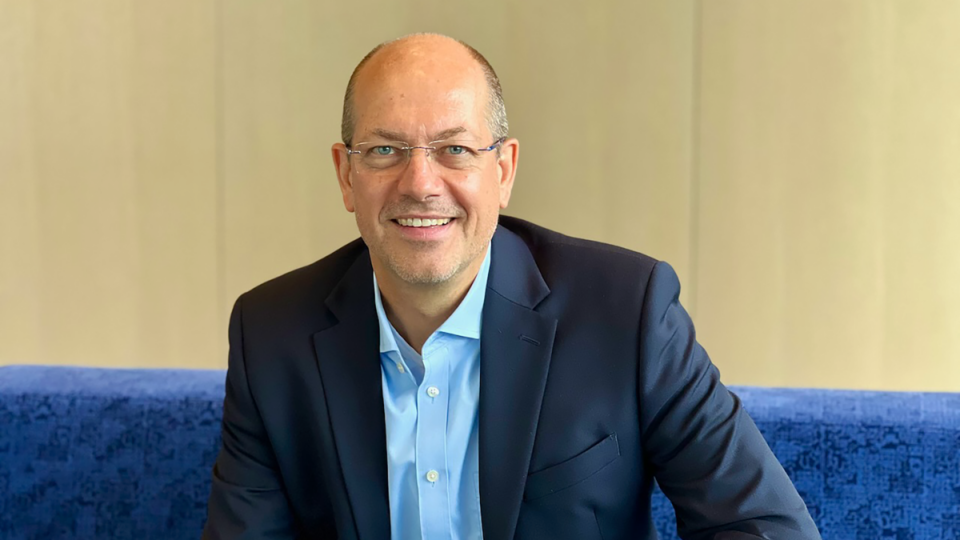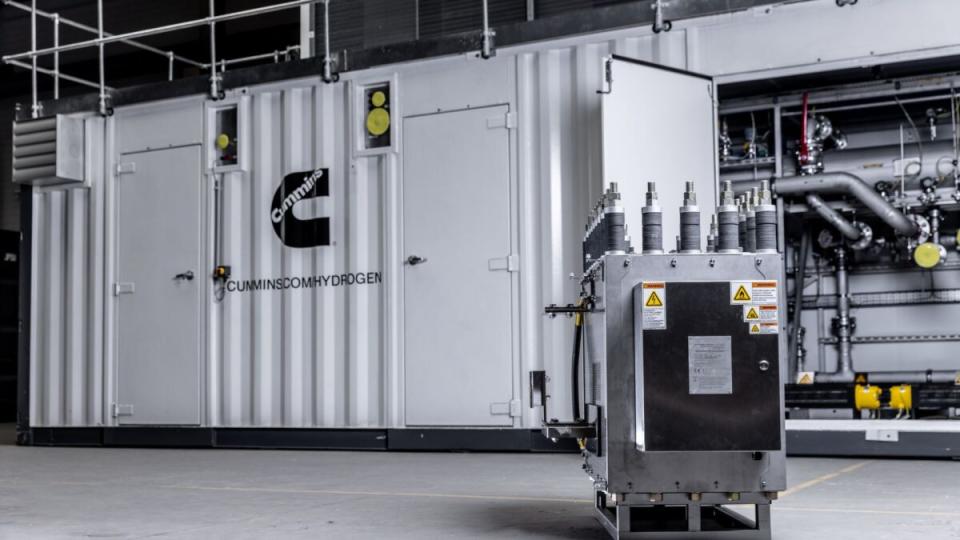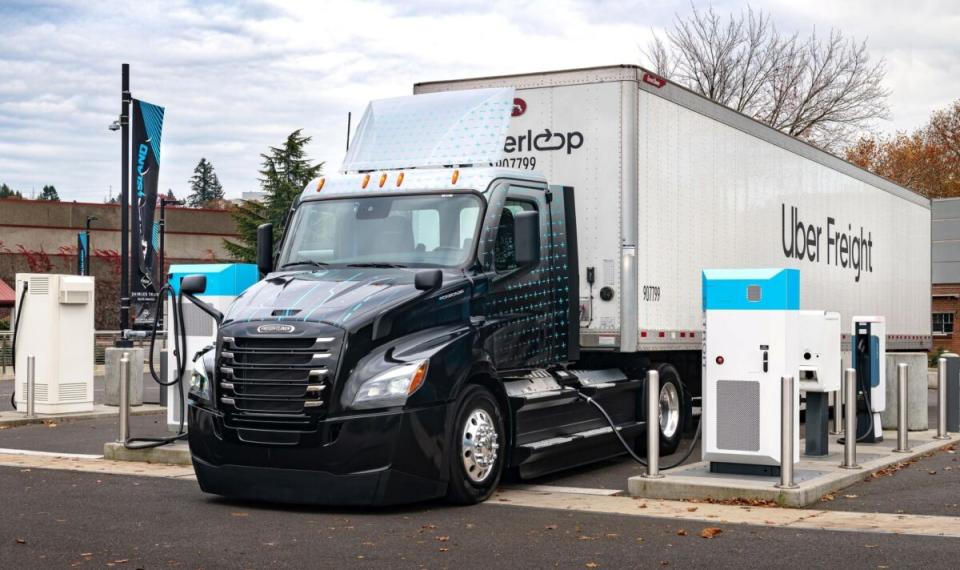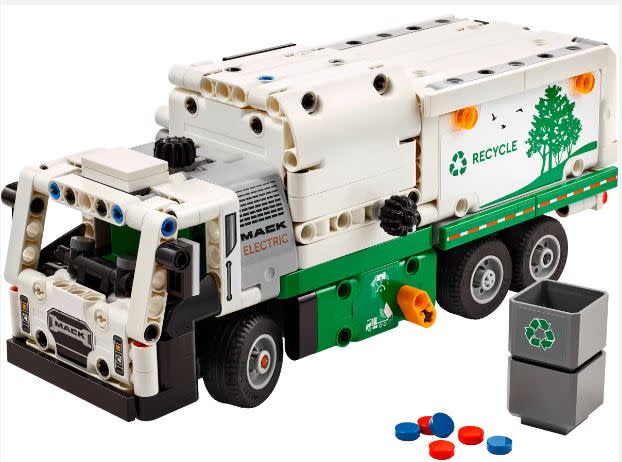Electrolyzers only scratch the surface of midcentury hydrogen demand

Even as manufacturing of electrolyzers grows, the hydrogen-making devices barely address the potential for hydrogen used in trucking and a host of industries. Cummins Inc. is doing its part.
Cummins has been investing globally in hydrogen-making electrolyzers as part of its Destination 2050 decarbonization plan. But even its aggressive approach won’t meet the midcentury demand for hundreds of millions of kilograms a year.
Hydrogen, a naturally occurring gas, is the most abundant substance in the universe. It emits only water vapor when burned. Green hydrogen is created using a process called electrolysis. Electricity from renewable sources is used to split the hydrogen molecules from the oxygen molecules in water emitting greenhouse-gas emissions.
Hydrogen could contribute more than 20% of annual global emissions reductions by 2050, according to McKinsey & Co. research.
That is a stretch target for even the most aggressive hydrogen equipment producers like Accelera by Cummins.
“We’re in the process of scaling up,” Andreas Lippert, Accelera by Cummins’ recently named vice president of electrolyzers, told me. “We’ve made these commitments in terms of manufacturing plants. We have about 300 megawatts of backlog up to 2026 in North America alone.”
Aggressive ramp-up
Accelera’s biggest single output of hydrogen is 10 tons per day. That might roll up to 360,000 tons a year. Industries from steel to ammonia use 70 million tons of hydrogen a year. Cummins’ largest current project is the 20-megawatt proton exchange membrane electrolyzer plant in Bécancour, Canada.
Commissioning is underway for a 25-megawatt plant with Florida Power & Light. Accelera also is working with German multinational chemical company Linde GmbH on a 35-megawatt electrolyzer installation at Niagara Falls where hydropower creates the electricity needed to make green hydrogen.
“If you believe even half of what McKinsey puts out there as 350 to 400 million tons a year by 2050, it’s a huge, huge space,” Lippert said.

Conversion amid irony
The company is converting more than 25% of its plant in Fridley, Minnesota — where President Joe Biden visited in April — to make electrolyzers. Is it ironic that the rest of the facility assembles diesel-powered generators, which detract from rather than help Cummins’ climate change ambitions?
“What is helpful to keep in mind is not to be so picky,” Lippert said. “We have to pursue every possible option if we really want to get to the goal of net zero by 2050. And so for Cummins, all of these things play together.”
Even as Cummins focuses on a future where fossil fuels recede in importance, they remain in the picture for a long time.

Avoiding making the good the enemy of the best
Making green hydrogen from renewable feedstocks like solar and wind power doesn’t mean it will end up being used that way.
“We can’t necessarily control every electron that comes into the electrolyzer,” Lippert said. “Florida Power & Light [has] a huge solar park. It’s solar power going in and hydrogen coming out. And that is being blended into combustion turbines to provide greener electricity, storing it in the form of hydrogen and making it available at a different time.”
Accelera avoids making the good an enemy of the best. If all-green hydrogen is the best, then green hydrogen blended with other feedstocks is the good.
“We’ve had a project with Enbridge in Canada that’s been running for quite a while where they’re blending [hydrogen] in. It is a meaningful step to decarbonize,” Lippert said. “Part of our Destination Zero message is, ‘Start today, even if it’s smaller steps.’ Cumulatively that has more impact than waiting on a magic technology at a future date.”
Electrolyzers and fuel cells: Opposites attract
An electrolyzer uses electricity and water to make hydrogen. It is the opposite of a fuel cell, which uses hydrogen to make electricity from hydrogen. But they can work together.
“The key where this electrolyzer fuel cell combination does come in is if you have lots of renewable power that you then can convert and buffer in the form of hydrogen and then run the fuel cell on that hydrogen to provide peaks of charging,” Lippert said.
Consider multiple megawatt charging stations addressing battery-electric and hydrogen-powered fuel cell trucks. Stationary fuel cells, like those planned by fuel cell developer Hyzon Motors, could charge overnight and provide power during peak periods when utilities assess demand charges.
“The electrolyzer and fuel cell combo makes sense if you have a lot of wind power at night, which is the case in a lot of regions,” Lippert said. “So you can store that wind power through the electrolyzer in hydrogen [and] smooth that curve.
“You actually need a very thick artery for some of these charging stations, and the grid just doesn’t have it. So you need to create large amounts of power in a very decentralized way with these EV charging stations. You need a way to get energy there. Hydrogen could be a way to address that.”
Briefly noted:
Electric commercial truck charging network service provider Greenlane and Uber Freight will collaborate to accelerate development of public charging infrastructure.

The Eaton Cummins Automated Transmission Technologies joint venture is making the Endurant XD series automated transmission available in certain Daimler Truck Western Star and Freightliner models.
Milence, the $593 million electric truck charging joint venture of Daimler Truck, Traton Group and Volvo Group announced in 2021, has opened the first phase of a charging hub in the Netherlands.
Our Next Energy (ONE) has named Paul Humphries as CEO, succeeding co-founder Mujeeb Ijaz. He will become chief technology officer of the Novi, Michigan-based energy storage technology company.
Bloomberg New Energy Finance reports that electric vehicles and fuel-cell vehicles are expected to avoid almost 1.8 million barrels of oil a day in 2023, or about 4.1% of road transport sector demand. CleanTechnica has more here.
Cheema Freightlines will use the Virtual Vehicle connected vehicle platform from Platform Science on its fleet of more than 500 trucks in the Western U.S.
Isuzu Motors has invested in an $85 million Series C funding round for Israeli startup Foretellix, which uses artificial intelligence to test the safety of autonomous vehicles.
The Ford Otosan joint venture in Turkey is reading an F-Max heavy-duty fuel cell truck for testing and it may explore fuel cells in delivery vans in the U.K., according to CleanTechnica.
And finally — though not in time for Christmas — Lego is offering a 503-piece building set based on the Mack LR Electric refuse truck. Looks pretty cool for those of us over 8 years old.

Truck Tech Episode No. 45: TruckWings takes flight as part of ConMet
The future of the TruckWings cab-to-trailer gap closing technology looks bright with the acquisition by ConMet.
That’s it for this week. Thanks for reading. Click here to get Truck Tech via email on Fridays. And catch the latest in major events and hear from the top players on Truck Tech at 3 p.m. Wednesdays on the FreightWaves YouTube channel. We value your feedback. Please write to me at aadler@freightwaves.com with comments and story suggestions.
Merry Christmas and Happy New Year. Truck Tech will return to your inboxes on Friday, Jan. 5, 2024.
The post Electrolyzers only scratch the surface of midcentury hydrogen demand appeared first on FreightWaves.
